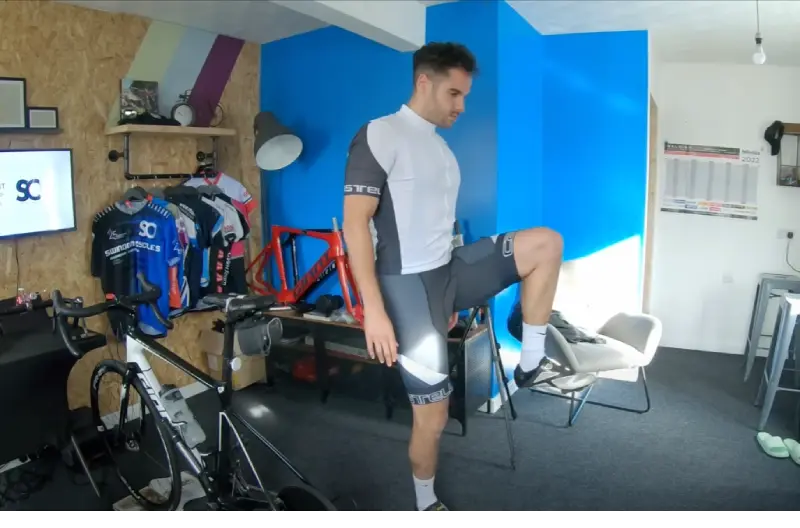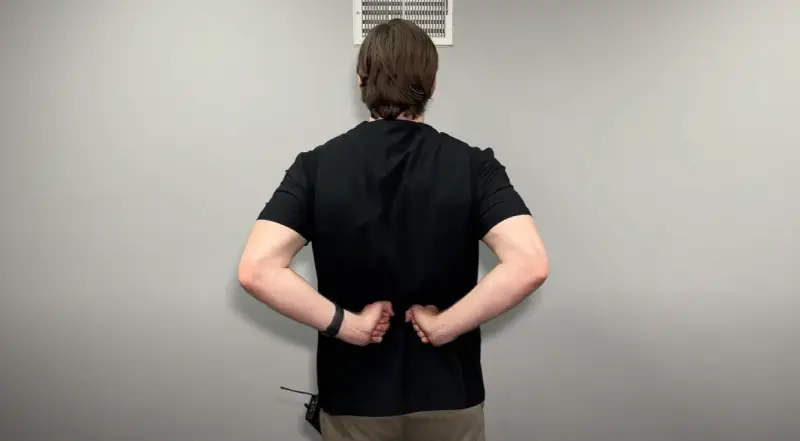A riding posture that is overly aggressive may cause the neck to be overextended to see ahead on the road, leading to muscle fatigue in the head-stabilizing muscles and subsequent pain.
To fix bad posture in a cyclist’s neck, ensure a proper bike fit to reduce weight on the upper limbs. Focus on eye level to maintain neck position and check spinal alignment. Incorporate mobilization exercises like Cat-Cow and strength exercises like Prone Head Lift.
This blog post explores the symptoms and diagnosis of neck issues in cyclists caused by poor posture. It also discusses preventive strategies and treatment options to address bad posture in the cyclist’s neck.
How To Fix Bad Posture In Cyclists’ Neck: 6 Easy Cures

Cyclists may experience stiffness and pain in the upper trapezius and neck muscles over time. The cervico-thoracic (C/T) junction is a primary area of discomfort. Here are some strategies to prevent these issues.
Proper Bike Fit to Prevent Cyclist’s Neck
Ensuring your bike fits you correctly is crucial for decompressing neck pain. Here are some tips and adjustments to hel
- Adjust Saddle Height: Your saddle should allow you to bend your knee slightly at its lowest point.
- Handlebar Position: Adjust the handlebars to level with or slightly below the saddle height.
- Reach and Stem Length: Make sure your back and neck are not strained by reaching the handlebars too far.
Strengthening Exercises for Cyclist’s Neck
Building muscle support in your neck can reduce strain and prevent pain. Try these exercises:
- Neck Tilts: Tilt your head forward, backward, and side to side. Hold each position for a few seconds.
- Shoulder Shrugs: Lift your shoulders and hold them for a few seconds, then relax.
- Chin Tucks: Pull your chin towards your chest, creating a double chin. Hold and release.
Flexibility and Stretching for Cyclist’s Neck
Maintaining flexibility in your neck is important for mobility. Incorporate these stretches:
- Neck Stretch: Keep your back straight while standing or sitting. Slowly turn your head to one side and hold, then switch sides.
- Upper Trapezius Stretch: Sit on one hand and gently pull your head toward your opposite shoulder.
- Levator Scapulae Stretch: Turn your head towards one armpit and gently pull down for a deep stretch.
Riding Technique Adjustments for Cyclist’s Neck
Improving your riding technique can make a big difference. Here are key changes to consider:
- Relax Your Grip: Avoid gripping the handlebars too tightly. A relaxed grip reduces tension in your upper body.
- Keep Elbows Slightly Bent: This helps absorb shock and prevents jarring movements.
- Look Forward: Keep your head up and look ahead rather than down at the front wheel.
Bad Posture Fixing In Cyclist’s Neck: Treatment Options

Cyclist’s neck, caused by poor posture during long rides, can be managed with physical therapy. This treatment eases current pain and prevents future issues. Expert guidance provides tailored exercises, posture correction, and therapy techniques like heat and cold for pain relief and neck health.
Physical Therapy for Cyclist’s Neck
Professional physical therapy can be very helpful in correcting bad posture and relieving neck pain. Here’s why:
- Expert Guidance: A therapist can provide personalized exercises and stretches.
- Posture Correction: Therapists teach proper posture to prevent future issues.
- Pain Relief Techniques: They use various methods like heat, cold, and manual therapy to reduce pain.
Self-Massage Techniques for Cyclist’s Neck
Self-massage can help relieve tension and promote healing. Here are some simple methods:
- Neck Roll: Use a foam roller or a tennis ball to gently massage the back of your neck.
- Trigger Point Release: Press and hold tender spots on your neck with your fingers for 10-15 seconds.
- Gentle Kneading: Use your fingertips to knead the muscles along your neck and shoulders gently.
Posture Corrective Tools for Cyclist’s Neck
Some gadgets and accessories can help maintain proper neck posture:
- Ergonomic Pillows: These pillows support proper alignment while you sleep.
- Posture Braces: Wearable braces gently pull your shoulders back to encourage good posture.
- Adjustable Desk Chairs: Chairs with good lumbar support can help keep your spine aligned.
Bad Posture In Cyclist’s Neck: Diagnosis & 7 Symptoms

Cyclist’s neck, also known as bicyclist’s neck or Shermer’s neck, is a common condition that affects many cyclists due to prolonged periods of riding in a forward-leaning position. Identifying the symptoms and seeking assessment can help manage and mitigate this condition effectively.
Causes of Cyclist’s Neck
Cyclist’s Neck, also known as “biker’s neck,” is a common problem among cyclists. It is important to understand the causes of this discomfort in order to prevent and alleviate this discomfort. This section will explore three main factors: bike fit, riding position, and muscle imbalances.
Bike Fit
A bike that doesn’t fit right can cause many problems, including neck pain.
- Incorrect Saddle Height: If your saddle is too high or too low, it can force you into an awkward position that strains your neck.
- Handlebar Position: Handlebars that are too far forward or too low can make you stretch your neck uncomfortably.
- Frame Size: A bike frame that’s too big or small can lead to poor posture and neck pain.
Riding Position
The way you sit and hold yourself on the bike is crucial.
- Slouched Posture: Slumping over the handlebars puts extra strain on your neck.
- Extended Neck: Keeping your neck extended while trying to look ahead can lead to stiffness and pain.
- Tense Shoulders: Holding your shoulders up by your ears creates tension that travels up to your neck.
Muscle Imbalances
Strong and balanced muscles support good posture.
- Muscle Weakness: If your core is weak, your neck and shoulders might have to do more work, leading to pain.
- Muscle Tightness: Tight chest muscles can pull your shoulders and neck forward, causing discomfort.
- Imbalanced Shoulder Muscles: If one side of your body is stronger, it can lead to uneven pressure on your neck.
Cyclist’s Neck Pain: Common Symptoms and Signs
Cyclist’s neck manifests through various symptoms that result from strain on muscles and joints in the neck. Here are some common signs and symptoms that may indicate you are suffering from cyclist’s neck:
- Neck Pain: One of the most common symptoms is pain in the neck region, which may be mild or severe. This pain often intensifies during or after long rides.
- Reduced Range of Motion: You may experience stiffness in your neck, making it difficult to turn your head from side to side or up and down. This rigidity can impact your ability to ride safely and comfortably.
- Upper Back and Shoulder Pain: Pain and tension can extend from the neck to the upper back and shoulders. This is due to the interconnected muscles and nerves in these areas.
- Headaches: Consistent neck strain can lead to tension headaches, characterized by a dull ache around the forehead or the back of the head and neck.
- Arm Numbness or Tingling: Sometimes, nerve compression causes numbness, tingling, or pins-and-needles sensations in the arms and hands. This is a sign that the nerves may be affected by muscle tightness or misalignment.
- Fatigue and Muscle Weakness: Chronic neck pain can lead to fatigue and muscle weakness, affecting performance on the bike and daily activities.
- Difficulty Maintaining Riding Position: If you find it increasingly challenging to maintain your normal riding position due to neck pain or discomfort, this could be a clear indicator of a cyclist’s neck.
Professional Assessment for Cyclist’s Neck
While self-care measures can help alleviate mild symptoms, seeking professional help is crucial if your symptoms persist or worsen. Here’s when and why you should consult a specialist:
- Persistent or Severe Pain: If you’re facing persistent or severe pain that doesn’t ease with rest or self-care, it’s crucial to consult a healthcare professional. Such pain could signal a deeper underlying problem requiring specialized treatment.
- Numbness or Tingling in Limbs: A medical professional should evaluate any numbness, tingling, or weakness in your arms or hands. These symptoms could be a sign of nerve compression that requires specific interventions.
- Impact on Daily Activities: If neck pain affects daily activities or riding ability, seeking professional advice is essential. A specialist can thoroughly assess the problem and recommend appropriate treatments or modifications to the cycling routine.
- Ineffective Self-Care: Suppose you’ve tried self-care measures such as stretching, strengthening exercises, and ergonomic adjustments to your bike without significant relief. In that case, a specialist can offer advanced therapies or diagnostic tests to understand the condition better.
- Assessment for Underlying Conditions: A healthcare professional can help determine if your neck pain is due to a cyclist’s neck or another underlying condition, such as cervical spine issues, arthritis, or muscular imbalances. Proper diagnosis is key to effective treatment.
Conclusion
With absolute clarity, isn’t it? Our posture’s impact on our cycling journey and overall well-being cannot be overstated. Hence, addressing and preventing Cyclist’s Neck is of utmost importance.
While it may appear daunting and lead to procrastination, every effort made, whether refining your bike fit, including specific exercises, or investing in posture-correcting aids, brings you closer to a healthier, more enjoyable cycling experience. It’s time for action; rest assured, your neck will thank you!
FAQs
Is Cycling Bad For Your Posture?
Cycling at a cadence of 90 rpm for seven hours weekly results in approximately 37,800 crank revolutions. With time, this repetitive motion may lead to muscle tightness in specific areas, impacting our posterior chain. A reminder that our body is interconnected. Such effects could also influence our posture when off the bike.


